-
Key Takeaways
-
The Four Components of Situational Awareness
- 1. Perception
- 2. Comprehension
- 3. Projection
- 4. Decision Making
-
Overcoming Information Overload in the Cockpit
- Common Sources of Information Overload
- Tips to Avoid Becoming Overloaded
-
Avoiding Task Fixation and Maintaining Focus
- Tips to Avoid Task Fixation
-
Handling Spatial Disorientation and Staying Oriented
- Tips to Avoid Spatial Disorientation
-
Mastering Multitasking in High-Stress Situations
- Multitasking Strategies and Techniques
-
Radio Communication and Understanding ATC
-
Conclusion
Situational awareness means staying aware of everything happening around you in the cockpit. For student pilots, it’s not easy to learn, since there’s so much to monitor.
Situational awareness relies on four parts:
- Noticing what’s happening (perception).
- Understanding it (comprehension).
- Predicting what could happen next (projection).
- Making smart choices based on all that (decision-making).
But if you’re wondering how exactly you can go about using these components, we’ve got you covered in this article.
Let’s get into it!
Key Takeaways
- Situational awareness relies on perception, comprehension, projection, and decision-making.
- Manage cockpit information by prioritizing critical data and avoiding task fixation.
- Trust your instruments to prevent spatial disorientation in low-visibility conditions.
- Practice clear communication with ATC to improve situational awareness.
The Four Components of Situational Awareness
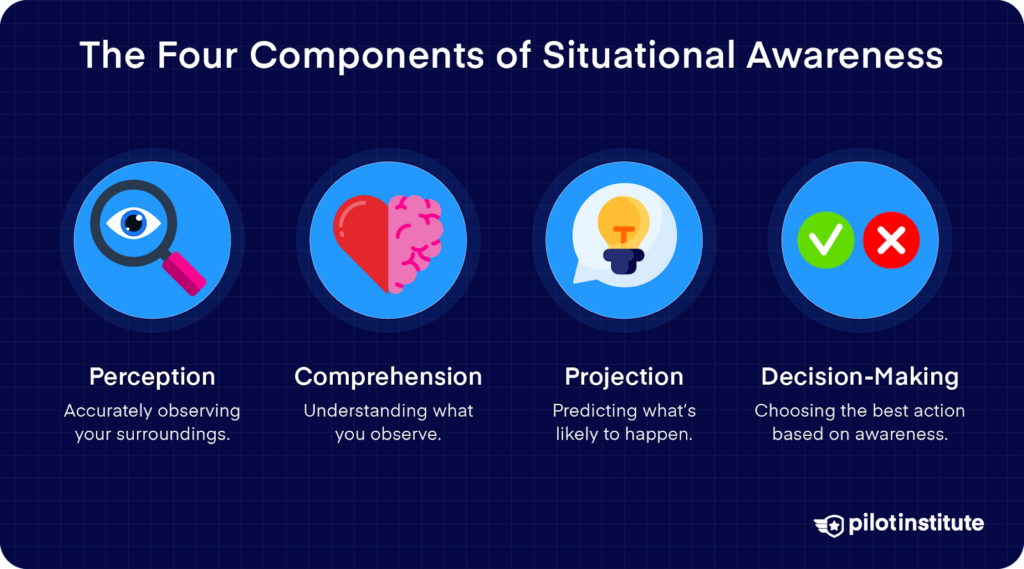
We have all heard that good situational awareness is essential if you want to be a great pilot. But what is situational awareness?
Situational awareness is knowing what is happening in the present and, based on that information, what may occur in the future.
To understand this concept in detail, we can break it into four core components. Let’s examine each one.
1. Perception
The first core component of situational awareness is perception. It’s the ability to recognize the current status of the environment or situation.
It involves using your senses, like sight and hearing. These observe and gather information around you.
Problems begin to occur if you fail to notice or remember key details or misinterpret them. These factors will impact your situational awareness.
2. Comprehension
Comprehension relates to understanding the relevant information that you have perceived.
We can build our understanding by combining the information we have perceived in real-time with our knowledge and experience.
A mental model is how we understand the world based on our knowledge, experience, and observations.
A key part of comprehension is updating or adjusting the mental model based on what we observe. We can then decide how these changes will affect our goals and objectives.
A breakdown in comprehension happens when our mental model is inaccurate or incomplete. This is often due to misinformation or a misunderstanding of the data.
3. Projection
Projection is the ability to think ahead in a given situation. It uses the information we have processed through our mental model to predict what will happen next.
If our mental model is incomplete, anticipated future events may be inaccurate.
4. Decision Making
Decision-making is the process of selecting the best course of action. This is based on your understanding of a current situation.
It’s the ability to make informed, timely, and effective decisions.
These decisions will be influenced by the previous three components. What you have perceived, how you have understood it, and what you predict will happen next.
This is why an accurate mental model with correct information is fundamental. Good situational awareness directly relates to effective decision-making.
Overcoming Information Overload in the Cockpit
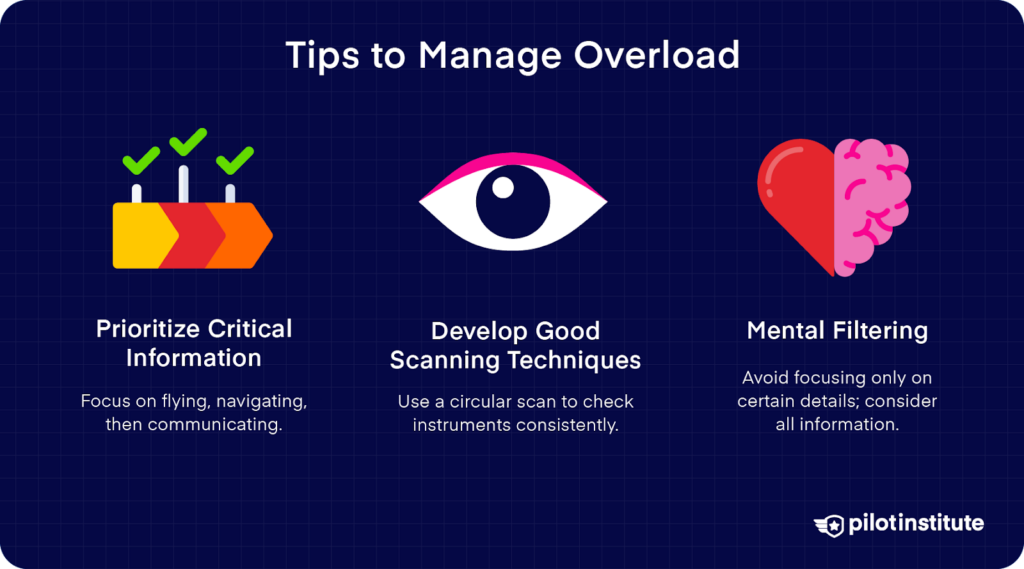
So, we now know the basics of situational awareness and its core components. But what happens when we face too much information for our brains to process?
You might have guessed it: information overload.
Information overload can leave us feeling stressed out and confused. Making us unable to make good decisions.
Common Sources of Information Overload
When flying, your brain works double time to process a large amount of information. Multiple processes are happening behind the scenes, contributing to your situational awareness.
Common sources of information include your flight instruments, radio, navigating, and flight controls.
Tips to Avoid Becoming Overloaded
Below, we have covered some tips to avoid becoming overloaded in the cockpit.
Follow these tips to become more aware of the vast amount of information in the cockpit and how we can manage it.
Prioritize Critical Information
We should prioritize the most critical information first. Creating a mental list from most important to least important.
This will help us feel less overwhelmed during busy periods of flight. It is important to prioritize the most critical information based on the situation.
When we are in the air, we must prioritize flying the aircraft. After that comes navigating and then communicating.
Develop Good Scanning Techniques
Cockpits can be overwhelming with all the switches and gauges. It can be hard to understand everything when they show us so much information.
A good scanning technique is required to help us process all this information.
The circular scan is an easy and adaptable scan that can help us with situational awareness.
The circular scan starts with the attitude indicator. It moves clockwise in a circular motion, scanning all six instruments. It is ideal for straight and level flight.
This scan pattern will build a consistent picture of the aircraft’s behavior.
Mental Filtering
Mental filtering is a bias where a pilot chooses to focus on specific information. While downplaying or ignoring important information.
This can lead to a skewed view of the situation, affecting decision-making.
It is important to diagnose in full and use all available information. Not jumping to any conclusions.
Avoiding Task Fixation and Maintaining Focus
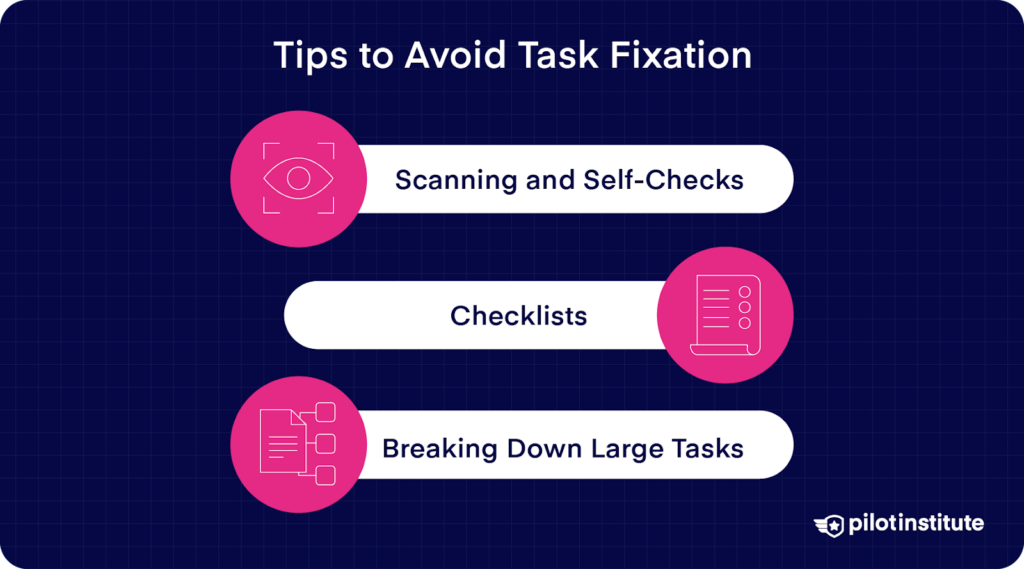
We all know how easy it is to become fixated on an issue. Humans are natural problem solvers, which can sometimes make us fixate.
Task fixation in aviation is dangerous. It can cause us to devote all our attention to a specific issue, meaning we lose focus on the main task. Flying the aircraft.
Situational awareness is compromised as soon as we divert our attention to one issue.
Tips to Avoid Task Fixation
We can do multiple things to combat task fixation and stay focused.
Scanning and Self-Checks
Keep up a good instrument scan while dealing with a problem. This will ensure we are not diverting all of our attention to an issue.
Use the circular scan. By doing this, we can gauge if the aircraft is still flying, which is our primary responsibility.
Carrying out self-check prompts will also increase our situational awareness.
Asking yourself questions such as “What’s around me?” and “Am I where I am supposed to be?” will ensure you are flying the aircraft first.
Checklists
Using checklists will help manage focus without losing sight of other tasks. In high workload situations, it is easy to forget standard actions.
Diverting our attention to a checklist will make sure that we have set the aircraft up correctly.
Breaking Down Large Tasks
When dealing with large and complex issues, it is easy to become fixated.
Breaking down tasks into small chunks will help us work through complex issues. It also allows us to remain focused on flying while doing so.
Handling Spatial Disorientation and Staying Oriented
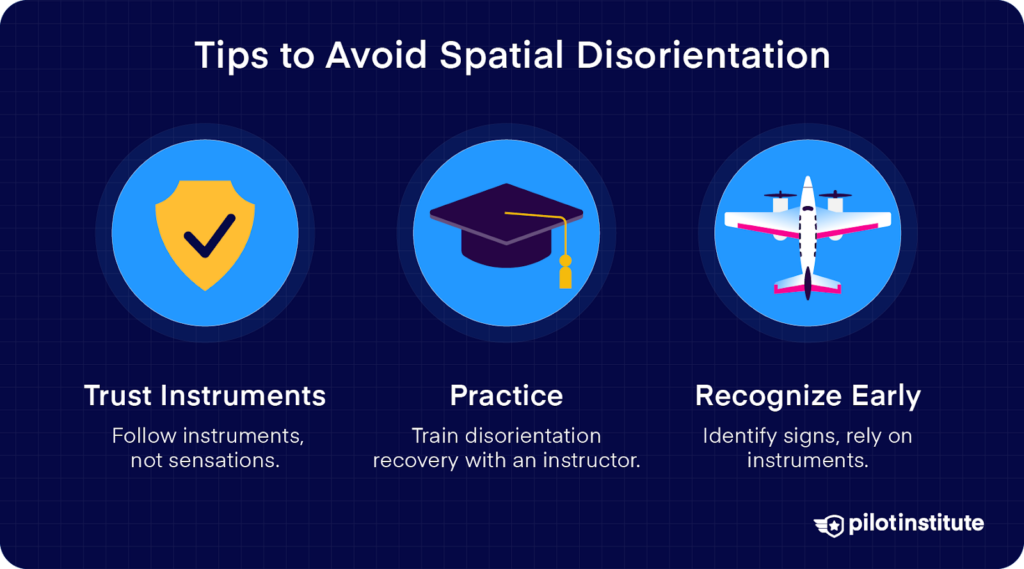
Statistics show that between 5% to 10% of all general aviation accidents can be attributed to spatial disorientation.
Spatial disorientation refers to the pilot’s inability to correctly perceive their aircraft position. This is often due to conflicting sensory inputs.
It occurs when visual cues such as the horizon or ground reference points are lost. Leaving the pilot to rely on their body’s sense of motion for orientation.
Common causes of disorientation include poor visibility, sudden turns, and loss of control.
Sounds scary, right?
The truth is that spatial disorientation does happen. It tends to occur when a pilot loses situational awareness.
This is why we must prioritize flying the aircraft!
So, how can we ensure this doesn’t happen to us?
Tips to Avoid Spatial Disorientation
Trust Flight Instruments
It’s never easy to go against what our body tells us. Our body will tell us one thing while the instruments tell us another.
In situations like this, it is important to trust our flight instruments. If we feel disoriented, we should return to the basic instrument scan.
Prioritize flying the aircraft. Focus on nothing else until you know your aircraft orientation, configuration, and position.
Practice Disorientation Exercises
Another way to avoid disorientation is to practice what actions you would take. Make sure to do this under the guidance of an instructor in a controlled environment.
If you’ve experienced spatial disorientation, you will know it can be stressful.
Carrying out disorientation exercises will ensure you are comfortable with this feeling. It will also teach you to know what to do if this situation ever occurs.
A simple disorientation exercise is to get your instructor to fly while you have your head down. The instructor will maneuver the aircraft for a period of time to confuse your senses.
Before taking over the aircraft, the instructor will put it into an unusual attitude. Either nose-high or nose-low.
From here, you will take over. Use the correct inputs to safely return to straight and level flight. Remember, your senses will be confused, so trust your instruments!
Recognize Disorientation Early
Recognition is the first step to prevention. As soon as you start to feel yourself entering a state of disorientation, be proactive about it.
Revert to your instruments, slow down, and keep up a good scan. This will help you regain your situational awareness.
Mastering Multitasking in High-Stress Situations
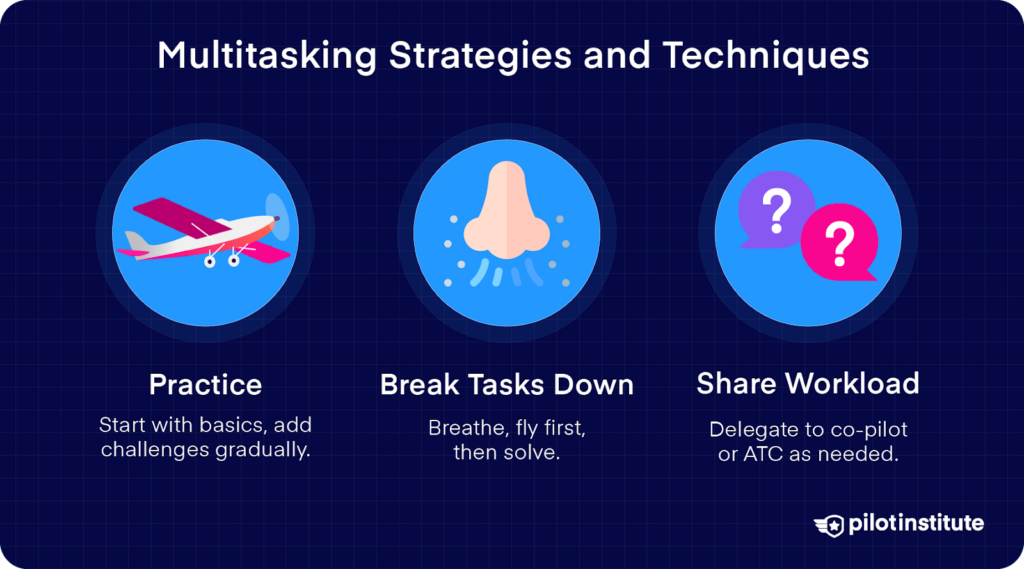
During periods of high stress, it is easy for us to become overwhelmed and fixated. As pilots, it is important that we remain calm and collected while we deal with issues.
It is essential to balance tasks like flying, navigating, and communicating. If we let one of these aspects slip, our situational awareness is compromised. This can lead to an incident.
So, how can we make sure our multitasking is up to scratch in high-stress situations?
Multitasking Strategies and Techniques
Practice
As the saying goes, practice makes perfect.
This is no different when learning to multitask. A good process is essential for performing under pressure. Use incremental training to slowly prepare for high-stress situations.
First, practice the basics of flight: flying, navigating, and communicating.
Once you have mastered this, slowly add minor issues to see how you would handle the situation. For example, a simulated alternator fault.
Adding an abnormal issue will distract you from the basics of flying. With practice, you can continue monitoring the aircraft while dealing with the issue.
Building yourself up to high-stress situations, where many things happen simultaneously.
Breaking Down Tasks
When something goes wrong, we usually do not expect it.
Our natural startle reaction can make an issue look worse than it is. This is due to the large amount of information our brain is trying to process at once. Breaking down tasks allows us to chunk bits of information so it is easier to process and work with.
When faced with an issue, pause and take a deep breath. This will reduce your stress levels and allow you to diagnose the problem rationally.
Remember to focus on the basics, like flying the aircraft. Once you know this is under control, you can begin to break down the task.
You want to diagnose the problem and see if it can be fixed. If it can’t, run any required checklists and decide whether you will return to land or divert.
Share the Workload
If you’re flying with another pilot or an instructor, share some of the workload with them.
Handing over control while you diagnose a problem can free up a lot of processing power. This allows you to focus on the issue.
If talking to ATC, request a heading and let them know you’re dealing with a problem, and you will get back to them. This will cover navigating and communicating.
As humans, we can’t handle everything at once. So, asking for help when necessary can reduce stress and workload. This will increase your situational awareness.
Radio Communication and Understanding ATC
We all know how hard it is to talk to ATC when first starting.
Learning a completely new language and communicating fluently in it takes time. But communication is key; if done incorrectly, it can be fatal.
When communicating with ATC, you must be clear and concise. Thinking before you speak will help you ensure you get it right the first time.
Practicing radio calls on the ground is an excellent way to familiarize yourself with them. The less you have to think about what you will say in the air, the greater your situational awareness will be.
Avoid common mistakes like talking too fast and missing key phrases. After receiving the radio call, stop, think, and repeat.
Don’t hesitate to ask ATC for help if you’re under a high workload and losing situational awareness.
Conclusion
It might initially feel challenging, but improving situational awareness takes time and practice. As you keep working on these four areas—perception, comprehension, projection, and decision-making—you’ll feel more in control and ready for anything.
Over time, staying aware becomes natural, helping you become safer and more confident in your abilities.



